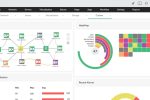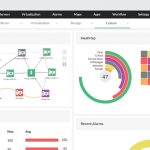By Uddhav Gupta, President, CloudBlue
Cloud computing opens the door for widespread access to cutting-edge technologies that are impacting everything from cybersecurity to the evolution of remote and hybrid work models to addressing the generational technology divide in the workforce. IT leaders seek to optimize strategies to harness these capabilities to boost efficiency, streamline processes, and tailor products and services to individual preferences across industries.
In this article, we delve into six industry trends to watch as these advanced technologies become more readily available and seamlessly integrated.
Data privacy & security
With global cybersecurity attacks on the rise, data privacy and security are paramount concerns for executives worldwide. How can products and services be tailored to prevent data leaks and unauthorized access? Safeguarding against cybersecurity threats is essential to prevent data breaches and ransomware attacks.
The General Data Protection Regulation (GDPR) provides a regulatory framework to enforce data protection. Collecting and processing data correctly are not only crucial to your organization’s future but also help you navigate today’s regulatory environment. Additionally, safeguarding against cybersecurity threats is essential to prevent data breaches and ransomware attacks. Companies can utilize cybersecurity as a service (CaaS) to access a suite of security services without having to invest in hardware and software infrastructure.
Digital proficiencies and flexibility
The hybrid work model is here to stay and with this trend the use of digital tools has become increasingly important. More and more organizations understand the importance of investing in and leveraging these tools to collaborate more efficiently with employees, customers and their ecosystems. The goal is to drive efficient communication methods, which is a new challenge for many companies.
This is a very interesting phase that the industry is going through where flexibility matters.
The adoption of, and ongoing support for, a hybrid work model reflects a company’s ability to accommodate diverse work preferences. This component has evolved significantly in response to the changes brought about by the COVID-19 pandemic.
Allowing employees to choose how they work in a hybrid setup is an acknowledgment of individual needs, which ultimately leads to fostering a satisfied and engaging workforce.
Gen Z and the generation gap
Different generations consume information and insights differently, and managing the generational gap is becoming an important part of today’s leadership priorities. As digital natives, members of Generation Z are looking at the same data and consuming it differently than other generations. According to a Pew Research Center survey, 75% of adults aged 18 to 29 were able to identify the presence of artificial intelligence (AI) in customer service chatbots, compared to 45% of those 65 and older.
AI and machine learning (ML) tools rely on data, and Gen Z is more open to sharing data, but not everyone shares Gen Z’s willingness to share data. Strategies should consider regional differences in data sharing norms or whether there is a geofence set up. Education is needed to ensure responsible data sharing practices. It is important to acknowledge that different generations perceive information differently and leaders should encourage cross-generational mentoring to bridge knowledge gaps.
AI & the future of work
This is a very interesting period in the evolution of technology with unparalleled transformation and innovation. The future of work is being reshaped by AI and ML, empowering businesses to transform infrastructure, revolutionize data analysis and input high levels of personalization in product development.
Enabling data-driven decisions is a key benefit of AI and ML tools. The early days of cloud migration were met with fear because while the cloud offers scalability, it also has the potential for runaway costs. AI and ML tools provide data analysis to predict and manage cloud infrastructure costs more effectively, including smarter resource allocation and elasticity, which contribute to better cost management.
The global cloud computing market was valued at $569 billion in 2022 and is projected to grow to more than $677 billion this year. Cloud providers not only contribute the fundamental building blocks for applications but have also helped to simplify AL and ML model development.
Edge computing
Traditionally, AI and ML were associated with large-scale data sets and cloud computing. However, advancements in edge computing have made it possible to apply AI/ML locally and in real time. This shift enables tasks such as image recognition and local analytics at the edge, reducing the need for centralized processing. The democratization of advanced technologies means integrating tools such as AI and ML into products will become increasingly accessible.
As the internet of things (IoT) continues to expand and demand for real-time data processing increases, edge computing enables more efficient and responsive solutions. By processing data closer to the source, you get low latency. Users experience faster response times, which is critical for applications where even slight delays can have severe consequences.
Edge computing can also enhance privacy and security by keeping sensitive data closer to its source and reducing the exposure to potential security threats during data transit. This is particularly vital in industries such as healthcare, finance and government with large silos of sensitive data.
Subscription models
Shifting from traditional one-time sales to subscription-based revenue models offers businesses a reliable and steady stream of income. Subscriptions also present a unique opportunity to cultivate and enhance customer relationships. By creating a more elastic delivery model, companies can significantly improve the overall customer experience.
Independent Software Vendors (ISVs), for example, can benefit from the subscription economy by establishing their own digital marketplaces. By offering a broader range of products and services, ISVs can enhance their value proposition and attract new customers who want to pay as they go. Selling services through third-party marketplaces also provides access to an expanded customer base. As businesses grow, their operations become increasingly complex.
End-to-end automation can streamline subscription management, catalog creation, order fulfillment and billing across multiple channels.
Innovation in the cloud
Realizing the full potential of AI and the cloud takes infrastructure and a layer of connectivity to optimize operations. According to McKinsey, organizations with advanced cloud-native architecture see resource utilization rates greater than 60 percent.
Partnering with a cloud monetization platform enables you to operate with sophisticated cloud architecture without the burden of building infrastructure from scratch. You also gain access to the platform’s catalog of products and solutions, and you can collaborate with the platform’s digital ecosystem of businesses. At this time of rapid growth of advanced technologies, staying at the forefront of AI, ML and cloud innovation will be crucial for businesses.




















